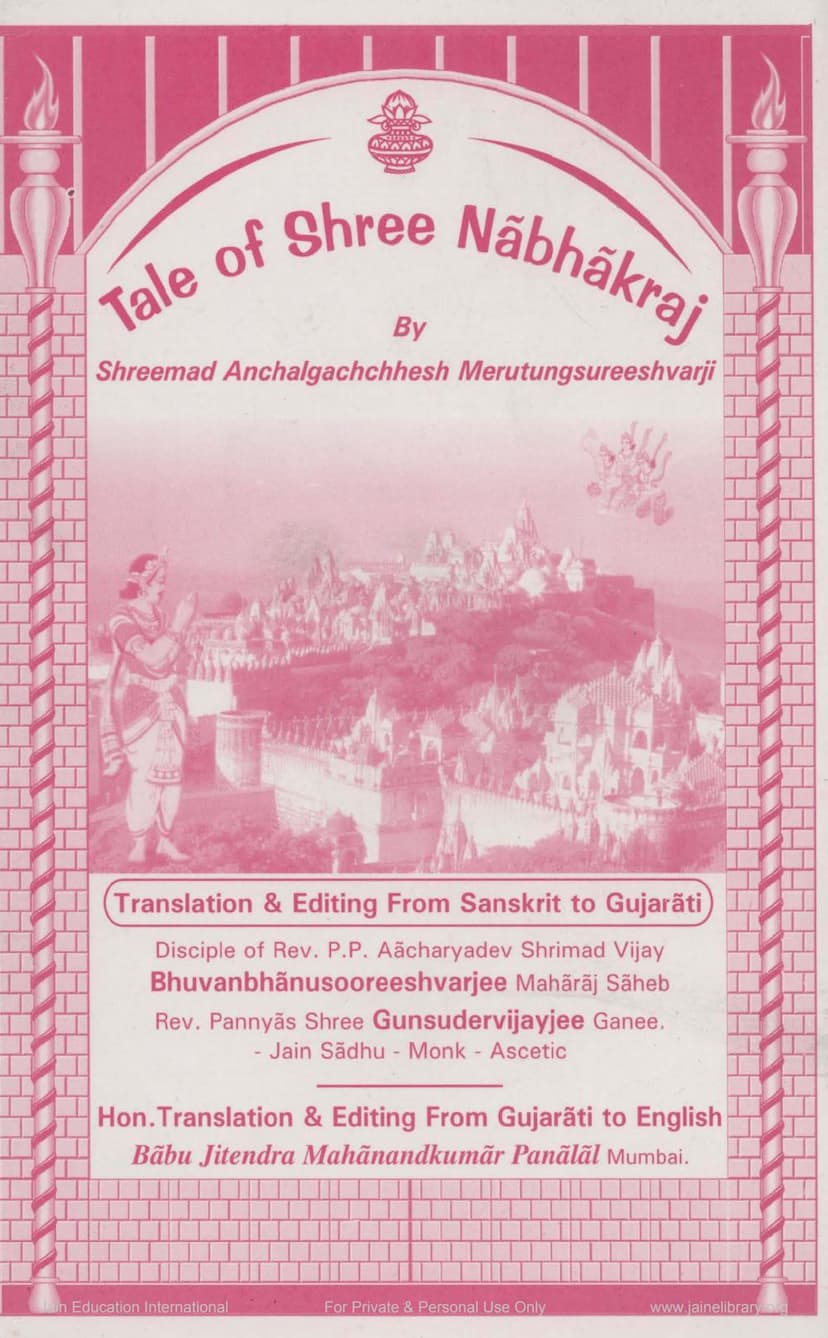Tale Of Shree Nabhakraj
Added to library: September 2, 2025

Summary
This document is a Jain text titled "The Tale of Shree Nabhakraj," authored by Merutungacharya and translated/edited by Gunsundarvijayji Ganee and Jitendra Mahanandkumar Panalal. It focuses on the Jain principles of Dev-dravya (wealth dedicated to God/temples) and the consequences of its proper use versus misappropriation.
Here's a comprehensive summary:
Core Theme: The Importance and Consequences of Dev-dravya
The central message of the text is the profound significance of Dev-dravya and the severe repercussions of misusing or misappropriating it. The book illustrates this through various stories and teachings.
Key Narratives and Teachings:
-
The Re-births of Rudradutt Brahmin and Sāgar: These sections (Page 4) graphically detail the karmic consequences of misappropriating Dev-dravya. Rudradutt, through his sin, endured numerous rebirths in hell and as various animals before eventually purifying his soul. Sāgar's story is similar, illustrating thousands of rebirths in different species and hellish realms due to his actions, ultimately only finding redemption after utilizing the wealth (which was originally Dev-dravya) for righteous purposes and eventually taking Diksha (initiation) and becoming a Tirthankar.
-
The Tale of Nabhakraj: This forms the main narrative. King Nabhak, a just ruler, intended to go on a pilgrimage to Shatrunjaya. He faced numerous obstacles, which were revealed to be due to past negative karmas. His spiritual guide explained these obstacles through the stories of two brothers, Samudra and Sinh.
-
The Story of Brothers Samudra and Sinh (and Nāg Kautumbik):
- Samudra: The elder brother, Samudra, was righteous. When they found a treasure buried by a family named Nāg, Samudra advocated for its use for the spiritual upliftment of Nāg. His intention was to protect Dev-dravya. This righteous act led to him becoming King Samudrapal, a virtuous ruler, and ultimately achieving Moksha (liberation) within three rebirths.
- Sinh: The younger brother, Sinh, was selfish and wicked. He misappropriated the Dev-dravya for personal gain, ignoring Samudra's warnings. This led to his downfall, experiencing immense suffering through countless rebirths in hells and as various animals, and a prolonged cycle of pain spanning 19 kotākoti sagaropam (an immeasurable period).
- Nāg Kautumbik: This narrative (Page 30) further illustrates the consequences. Nāg Kautumbik misused Dev-dravya, leading to the destruction of his family and suffering in hell. Later, as King Chandraditya, he unknowingly committed further sins, including the destruction of a pilgrimage site. Through the guidance of a Muni and by building a temple, he began to purify himself. He eventually understood his past karma through the story of Samudra and Sinh. His eventual attainment of deity status and then Moksha is shown as a result of his later righteous deeds.
-
The Donkey's Fate: The story of the donkey (Page 35) powerfully illustrates the long-term karmic repercussions of misappropriating Dev-dravya. The donkey is revealed to be the soul of Sinh, having endured numerous rebirths due to his initial sin of misappropriating 12,000 dinārs of Dev-dravya. This highlights how even a seemingly small misuse can lead to immense suffering over lifetimes.
-
The Importance of Shatrunjaya Teerth: The text emphasizes the immense spiritual merit and purity gained from pilgrimages to Shatrunjaya, describing it as a place that destroys sins and leads to liberation. Various scriptures are quoted to highlight its sanctity.
-
Nullifying Sins: The book explains that sins, especially those related to the destruction of Dev-dravya or pilgrimage sites, can be purified through severe penance, righteous deeds, and the erection of temples. King Nabhak's journey and penance exemplify this.
-
The Definition and Proper Use of Dev-dravya:
- Dev-dravya is defined as wealth, assets, and property dedicated to the idols and temples of Jain Tirthankaras.
- It is strictly meant for temple repairs, construction, idol adornment, and worship-related expenses.
- Using Dev-dravya for schools, colleges, hospitals, or general welfare of the Jain community (unless directly related to the temple's spiritual purpose) is considered misappropriation and a sin.
- Even wealth derived from dreams or other devotional activities related to the Tirthankara is considered Dev-dravya.
-
Causes of Downfall: The text lists four major sins in Jainism:
- Destruction of Chaityadravya (which includes Dev-dravya).
- Killing a Sadhu (monk).
- Speaking ill of the Jain Shasan (teachings).
- Having sexual relations with a Sadhvi (nun).
-
Advice on Financial Administration: A significant portion (Pages 65-68) provides practical advice for the transparent administration of Sangh (religious community) funds, emphasizing accountability, proper record-keeping, regular audits, and preventing fraud and mismanagement of Dev-dravya.
Overall Message:
"The Tale of Shree Nabhakraj" serves as a cautionary tale and a guide for Jains. It strongly advocates for the protection, preservation, and proper utilization of Dev-dravya as per scriptural injunctions. The narrative emphasizes that righteous actions, especially concerning Dev-dravya, lead to spiritual progress, heavenly births, and ultimately Moksha. Conversely, any misappropriation results in severe suffering across multiple lifetimes, a stark reminder of the law of karma. The book encourages devotion to Tirthankaras and adherence to Jain principles for ultimate spiritual fulfillment.